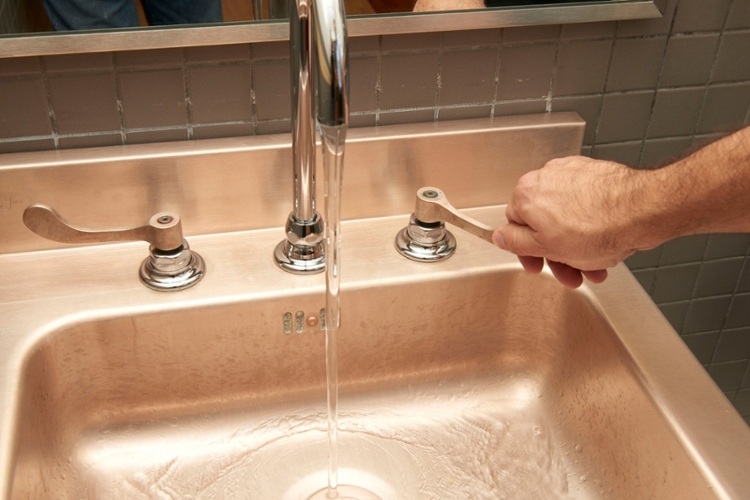Copper has impressive antimicrobial properties. So impressive, in fact, that our ancestors were using it for those properties long before humans had a concept of microbes or any way to understand why water stored or transported in copper vessels stayed more pure and more clean than water stored or transported in other ways.
And it’s not just pure copper. Copper alloys (brasses, bronzes, and others) share these incredibly useful antimicrobial properties.
How it Works

source: copper.org
When microbes land on a copper or copper alloy surface, such as through sneezing or coughing or touch, to name just a few examples, the metal releases electrically charged particles called copper ions. These ions kick microbial butt. They pierce the bacterial cell membrane or disrupt the viral coat, they destroy the DNA or RNA inside the microbe, and they prevent cell respiration.
What it Works On
Copper’s antimicrobial superpower seems particularly effective against a handful of common problem-microbes. Notably, copper and its alloys can kill off E. coli, MRSA, influenza A, adenovirus, various fungi, and clostridium difficile.
Where Can Copper Be Used?
Copper in Doctor’s Offices

source: circarealestategroup.com
Aside from the many medical uses of things like copper tubing and other applications, the potential of replacing certain surfaces in high infection risk areas of doctor’s offices could make a big impact on the spread of disease.
Such places include, but are not limited to, doorknobs and door handles, sink faucets and handles, toilet flush handles, countertops at the check in and check out desk, and light switches.
Essentially, anything that is likely to be touched by many people, particularly in an environment like a doctor’s office or a hospital where many of those people are likely to either be ill, or to have encountered someone who is ill, could be replaced with copper and help slow the spread of germs and illness.
Copper in Public Transportation
Picture a crowded subway car, all the passengers hanging on to the bars to help their balance. And the people who were there before them. And the people who came before that. And before that. And before that. And….
It’s not feasible to clean every high-traffic part of every mode of public transportation between every stop. And the average person riding the trains or busses or anything else may know they should wipe their area down with a disinfectant wipe before touching, but it doesn’t usually happen.
Replacing these fixtures with copper wherever possible would do a lot to combat common illnesses.
Copper in Buildings

source: aspiremetro.com
Schools. Public buildings. Workplaces. Anywhere with a handrail for a staircase, doorknobs, light switches, public or common use bathrooms, and shared surfaces is a vector for disease. Especially schools, full of little children who don’t yet have good hygiene skills. Again, the antimicrobial properties of copper and copper alloys could be put to use for everyone who encounters them.
How to Make it Work for You
All the ways that copper can benefit the general population in spaces such as transportation, medical centers, and public locations can be applied on a smaller scale in your home as well.
In terms of small-scale projects, replacing the doorknobs in your home is not a monumental task. It is also not difficult or particularly expensive to change your light switch plates out for copper ones.
Personal items can get a copper touch, too. Many people don’t realize how very germy their phones are, for example, but a copper phone case could really help mitigate that particular problem.
Fixtures such as bathroom sinks and shower and tub faucets and handles would prove to be both more costly and more time-consuming. Weigh the price and commitment to the work against the antimicrobial benefits before deciding to take this step.
Replacing some of your kitchen items with copper or copper alloys could be as low-stress as simply changing out the parts you’re most likely to touch, such as the handles or knobs on your sink’s faucet and, again, doorknobs and light switches.
Or perhaps you’ve learned about the antimicrobial properties of copper just as you’re contemplating having a new kitchen built or majorly remodeling an old one, in which case you have the opportunity to replace all of your major (frequently touched) appliances with copper or a copper alloy. This is easier than you may think, and with the availability of details like copper cabinet handles and appliances like copper vent hoods, the use of this antimicrobial material can be consistent throughout your entire space so that you do not sacrifice one bit of style.
Use your imagination. What ways could copper help keep you safer from disease?
What Are the Drawbacks?

source: pinterest.com
In the public sphere or in your own home, making large scale replacements of any kind has a cost associated with it. These sort of projects, therefore, may take considerable time to complete.
Copper or copper alloy surfaces and appliances may require different care than the cleaning and maintenance you’re currently accustomed to in your school or workplace, on the train or bus, or in your home. It may take a little extra effort and time to make sure these things are properly maintained.
Make Use of Natural Metals
Copper and its alloys are not the only metals with antimicrobial properties, and all of them are very effective in their ability to help us protect ourselves from certain diseases. An ability our ancestors used without fully understanding and an ability that we, with greater knowledge at our disposal, can use even more effectively.



